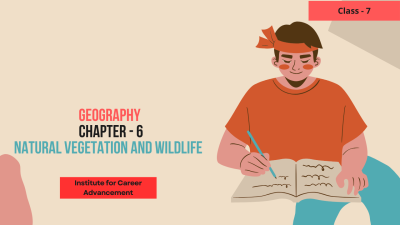Natural Vegetation and Wildlife - Class 7
Natural vegetation refers to the plant life that grows naturally in a particular region without human interference. It is influenced by factors like climate, soil, and topography. Types of Natural Vegetation: Forests: Dense growth of trees. Tropical Evergreen Forests: Found in regions with heavy rainfall, characterized by tall trees with diverse flora and fauna. Tropical Deciduous Forests: Found in areas with seasonal rainfall, trees shed their leaves during the dry season. Temperate Evergreen Forests: Found in areas with moderate rainfall, dominated by coniferous trees. Temperate Deciduous Forests: Found in areas with four distinct seasons, trees shed their leaves in autumn. Grasslands: Areas dominated by grasses. Tropical Grasslands (Savannas): Found in tropical regions with distinct wet and dry seasons. Temperate Grasslands (Prairies): Found in temperate regions with moderate rainfall. Deserts: Areas with sparse vegetation due to low rainfall. Tundra: Found in cold regions, characterized by low-lying shrubs and mosses. Wildlife: Wildlife refers to all the animals, birds, insects, and other organisms that live naturally in a particular region. It includes a wide variety of species, from tiny insects to large mammals. Relationship between Natural Vegetation and Wildlife: Natural vegetation provides food, shelter, and habitat for wildlife. In turn, wildlife plays a crucial role in seed dispersal, pollination, and maintaining the ecological balance. Conservation of Natural Vegetation and Wildlife: National Parks and Wildlife Sanctuaries: Protected areas where wildlife is conserved. Afforestation and Reforestation: Planting trees to restore degraded forests. Sustainable Use of Natural Resources: Using natural resources wisely to minimize environmental impact. Awareness and Education: Creating awareness about the importance of conserving natural vegetation and wildlife. প্রাকৃতিক গাছপালা বলতে সেই উদ্ভিদ জীবনকে বোঝায় যা মানুষের হস্তক্ষেপ ছাড়াই একটি নির্দিষ্ট অঞ্চলে প্রাকৃতিকভাবে বৃদ্ধি পায়। এটি জলবায়ু, মাটি এবং ভূসংস্থানের মতো বিষয়গুলির দ্বারা প্রভাবিত হয়। প্রাকৃতিক উদ্ভিদের প্রকারঃ বনঃ গাছের ঘন বৃদ্ধি। ক্রান্তীয় চিরহরিৎ বনঃ বিভিন্ন উদ্ভিদ ও প্রাণীজগৎ সহ লম্বা গাছ দ্বারা চিহ্নিত ভারী বৃষ্টিপাতের অঞ্চলে পাওয়া যায়। ক্রান্তীয় পর্ণমোচী বনঃ মৌসুমী বৃষ্টিপাতের অঞ্চলে পাওয়া যায়, শুষ্ক মরসুমে গাছগুলি তাদের পাতা ঝরিয়ে দেয়। নাতিশীতোষ্ণ চিরহরিৎ বনঃ শঙ্কু গাছ দ্বারা প্রভাবিত মাঝারি বৃষ্টিপাতযুক্ত অঞ্চলে পাওয়া যায়। নাতিশীতোষ্ণ পর্ণমোচী বনঃ চারটি স্বতন্ত্র ঋতু সহ অঞ্চলে পাওয়া যায়, গাছগুলি শরত্কালে তাদের পাতা ফেলে দেয়। তৃণভূমিঃ ঘাস দ্বারা প্রভাবিত অঞ্চল। ক্রান্তীয় তৃণভূমি (সাভানা) ক্রান্তীয় অঞ্চলে স্বতন্ত্র আর্দ্র এবং শুষ্ক ঋতু সহ পাওয়া যায়। নাতিশীতোষ্ণ তৃণভূমি (প্রেইরি) নাতিশীতোষ্ণ অঞ্চলে পাওয়া যায় যেখানে মাঝারি বৃষ্টিপাত হয়। মরুভূমিঃ কম বৃষ্টিপাতের কারণে বিরল গাছপালা সহ অঞ্চল। তুন্দ্রাঃ শীতল অঞ্চলে পাওয়া যায়, নিচু ঝোপঝাড় এবং শসা দ্বারা চিহ্নিত। বন্যপ্রাণীঃ বন্যপ্রাণী বলতে একটি নির্দিষ্ট অঞ্চলে প্রাকৃতিকভাবে বসবাসকারী সমস্ত প্রাণী, পাখি, পোকামাকড় এবং অন্যান্য জীবকে বোঝায়। এর মধ্যে রয়েছে ক্ষুদ্র পোকামাকড় থেকে শুরু করে বড় স্তন্যপায়ী প্রাণী পর্যন্ত বিভিন্ন প্রজাতির প্রজাতি। প্রাকৃতিক উদ্ভিদ ও বন্যপ্রাণীর মধ্যে সম্পর্কঃ প্রাকৃতিক গাছপালা বন্যপ্রাণীর জন্য খাদ্য, আশ্রয় এবং আবাসস্থল সরবরাহ করে। ফলস্বরূপ, বন্যপ্রাণী বীজ বিতরণ, পরাগায়ন এবং পরিবেশগত ভারসাম্য বজায় রাখতে গুরুত্বপূর্ণ ভূমিকা পালন করে। প্রাকৃতিক উদ্ভিদ ও বন্যপ্রাণী সংরক্ষণঃ জাতীয় উদ্যান ও বন্যপ্রাণী অভয়ারণ্যঃ সংরক্ষিত এলাকা যেখানে বন্যপ্রাণী সংরক্ষণ করা হয়। বনায়ন ও বনায়নঃ অবক্ষয়প্রাপ্ত বন পুনরুদ্ধারের জন্য গাছ লাগানো। প্রাকৃতিক সম্পদের টেকসই ব্যবহারঃ প্রাকৃতিক সম্পদকে বিজ্ঞতার সঙ্গে ব্যবহার করে পরিবেশগত প্রভাব কমিয়ে আনা। সচেতনতা ও শিক্ষাঃ প্রাকৃতিক উদ্ভিদ ও বন্যপ্রাণী সংরক্ষণের গুরুত্ব সম্পর্কে সচেতনতা সৃষ্টি করা।
English
Last updated
Mon, 23-Dec-2024



















